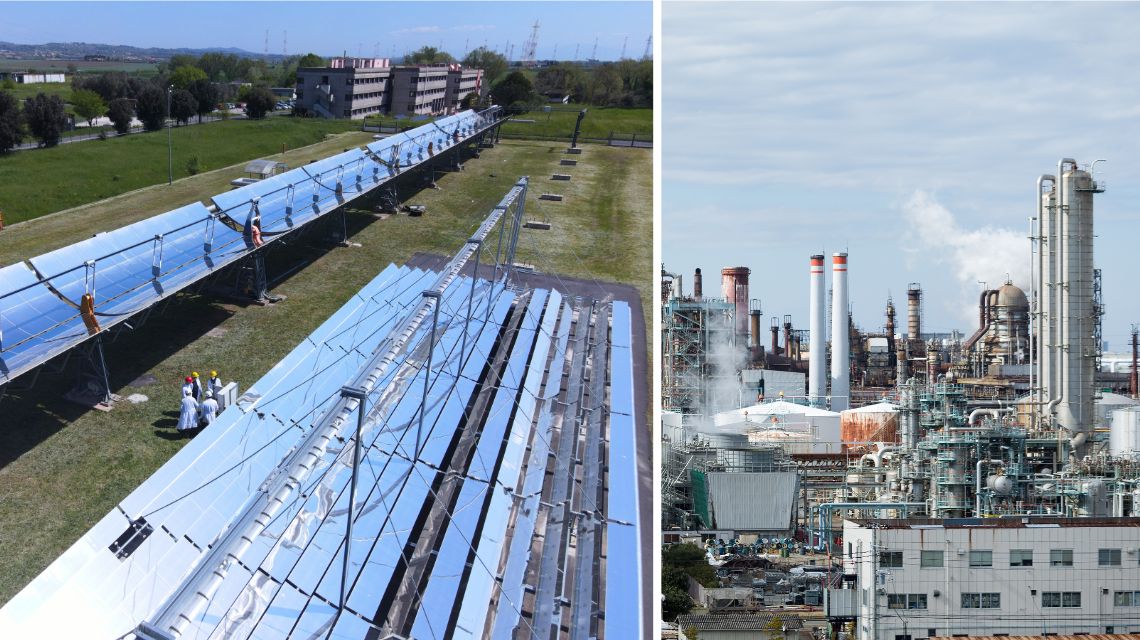Italian National Agency for New Technologies, Energy and Sustainable Economic Development

Energy: Oil, using concentrating solar heat to decarbonize refining processes
A study conducted by ENEA and the University of Palermo [1], promoted by the Ministry of University and Research and published in the journal Energy, shows that a concentrating solar power plant in an oil refinery would reduce carbon dioxide emissions (about 54 thousand tons/year) and the amount of methane used (about 20 thousand tons/year) to produce heat used in crude oil distillation, by more than 10 percent.
“Crude oil distillation is recognized as one of the most energy-consuming processes, responsible for about 30-40 percent of the overall demand” explained Alessandro Galia of the University of Palermo. “This study” Galia said, ”shows how the heat produced by a concentrating solar power plant could be effectively and economically integrated into the distillation process and achieve two goals: a significant decarbonization of refinery activities and a reduction in methane consumption, particularly for those plants located at high solar irradiance. However, solar heat integration with the distillation process is complex because it requires the development of a strategy to economically balance the intermittency in solar radiation with continuity at refineries.”
The system hypothesized in the study is based on the use of linear solar collectors each 100 meters long, with a mirror width of 5.8 meters, equipped with a receiver tube where a mixture of molten salts, known as “solar salt” flows, which performs the function of transfer fluid and heat storage.
“We considered different configurations of the renewable plant by varying the integrated solar power (50 and 70 MW) and solar array extension (80 and 100 strings or loops [2], of 6 solar collectors each), setting a maximum capacity of the hot storage tank at 800 thousand kWh. All this thanks to the possibility of tuning the power of typical distillation furnaces and, as a result, obtain a hybridized plant” said Giampaolo Caputo, researcher at the ENEA Energy and Data Science Laboratory of the Energy Technologies and Renewable Sources Department.
The team calculated that the maximum size of the concentrating solar power plant is limited to 100 loops (about 330 thousand square meters of collector area) and is capable of constantly supplying the process with solar heat, including the 'charge' of thermal energy storage for 24 hours of operation on clear days.
The study was then completed with a techno-economic analysis--performed on a simulated case by reprocessing actual operating data from an Italian refinery--which estimates a 16.2 percent rate of return on investment for the installation of the concentrating solar power plant for the particular irradiance situation considered [3].
The impact of this hybridization on CO2 emissions and fuel consumption was then estimated assuming the same refinery located in the United Arab Emirates. The study shows that the two sites considered do not differ significantly in the maximum daily intensity of direct radiation, but rather in the distribution of solar irradiation throughout the year (more uniform at the Arabian Peninsula site), which allows for a higher CO2 abatement rate of 17 percent (about 3,800 hours at Milazzo in Sicily and 4,100 hours in the UAE). “This shows that high-temperature solar heat integration would be of interest in particular for refineries located in areas characterized by a high solar radiation and with sufficient space to install solar fields close to crude distillation units,” concluded Giampaolo Caputo of ENEA.
Notes
[1] Co-funded with the PNRR funds from the extended partnership NEST - Network for Energy Sustainable Transition, Spoke1, Objective 4 link
[2] Loops refer to closed circuits through which heat transfer fluid (such as molten salts) circulates to collect and transfer heat. Each loop typically comprises a set of solar collectors, like parabolic mirrors or heliostats, which focus sunlight onto a receiver, heating the heat transfer fluid. In the present case, a loop consists of 6 parabolic solar collectors of 100m and thus a total length of 600m. A larger number of loops means a larger collector area and a larger solar energy collection and transfer capacity.
[3] It would drop to 8.5 percent in the case of an electrolyzer for green hydrogen production from photovoltaics of the same size, orientation and tracking as the concentrating solar power plant considered in the study and a cut in CO2 and methane of 'just' 24 and 9 thousand tons/year, respectively.
